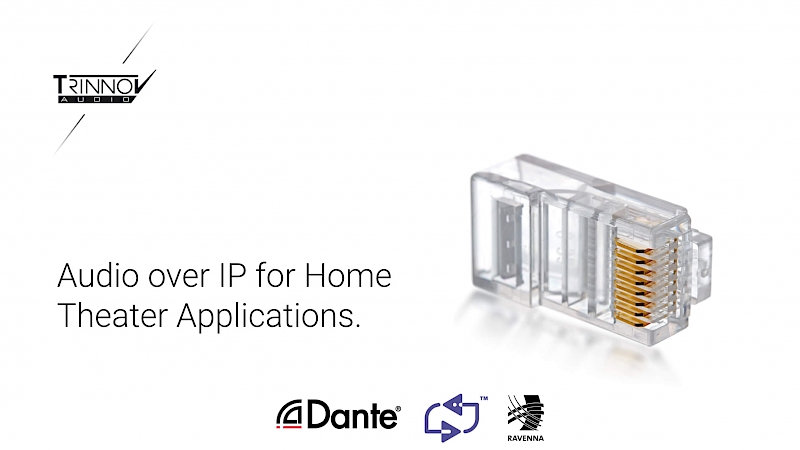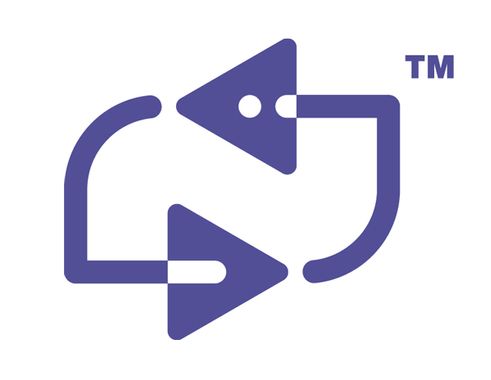
Introduction
In this blog post, we aim to address the growing requirement for Audio over IP in Home theater applications. We will discuss the pros and cons of the technology and give you an overview of the different technologies available to you from Dante, Ravenna, AVB and the convergent standard AES67.
We will then discuss their place in Home Theater applications. Be warned if you are not comfortable with networking this might feel quite intimidating. Mainly due to the overuse of acronyms!
This is a very complex topic. We hosted a webinar as an Introduction to AoIP that you might find useful before reading this document or to learn more following this introduction.
First of all what is Audio over IP?
AoIP is a network protocol(s) that allows you to send high-quality digital audio signals over the IP network. This is made via a single cable such as Cat5e or Cat6 or higher data rate cables like fibre.
This is not a new idea, as the first AoIP networks were commercially available in the 90’s. Probably some of you have installed and set up some on these networks like CobraNet or EtherSound. Both protocols are classed as Audio over Ethernet. No router is required, it's just a point-to-point audio network over Ethernet.
The technologies we are talking about today are including the Network Layer 3 (refer to OSI Model) where routers, compatible network switches and equipment are often but not always required. “Dumb” or unmanaged switches are acceptable if it’s only audio traffic that is involved and is limited to a single switch.
The IP protocol is based on and works with a number of widely deployed standards. IP as a transport protocol can operate on many network infrastructures and virtually any existing network equipment; it is not bound to a specific technology or topology. To minimize potential negative effects from rivaling bandwidth requirements of other shared services on the network, effective Quality of Service mechanisms like DiffServ and VLAN are available. They are supported in most network environments.
What options are available on the market?
There are a number of different standards available on the market but we are going to talk about the main 4 you will come across. There are other options, but these are typically manufacturer-specific and are closed protocols for that system.
A good example is SpeakerLink from Meridians 271 Digital theater Controller. It provides a point-to-point connection between the controller and speakers. It's not an AoIP technology rather a transport over Ethernet. We won't be covering these here as we have enough to cover already.

Dante
Launched in 2006 by Audinate, Dante is not focused on one market sector, so this helps to broaden the adoption within all audio markets. Dante is a proprietary technology with hardware implementation that is licensed to manufacturers to implement their own products or implement into existing products.
More than 2000 devices from 300+ companies are Dante-compliant and products are available across many market sectors from Corporate, Education, Broadcast, Live performance and of course Home AV. This makes it effortless for customers to add devices to the audio network knowing that they are going to work once setup.
With AVIO network adapters available it's easy and cost-effective to convert your existing; Analog, Bluetooth, USB or AES3 devices to Dante. Dante audio is 100% lossless. 24- or 32-bit, and sample rates from 44.1 kHz to 192 kHz are supported. Hundreds of channels can be managed depending on the application, hardware, and bandwidth available.
Setup is relatively straightforward thanks to the Dante Controller software run on either Mac or PC for setup and monitoring. The controller does not have to be permanent. It can be accessed just to add new devices or check the status of things like firmware on all your devices on the audio network.
The benefit of this control software is the automatic discovery of devices. This makes it much easier to find devices and add them to the network. Presets can also be saved and recalled to change audio routing options.
Dante also has cross-compatibility with AES67 so if your device is Dante compatible it should be able to either send or receive audio from an AES67 source.

Audio Video Bridging
The first IEEE standards that defined AVB came out in 2009 and revised until 2013. AVB is an Audio over Ethernet technology as it relies on layer 2 protocols to reserve connection bandwidth, prioritizing network traffic, and defining the clock.
Like the ones mentioned in the introduction, it's primarily used in live sound applications. However, some companies have AVB products for the residential markets as well, such as Savant and speaker manufacturers like L-Acoustics and Ascendo Immersive Audio. Compatibility with other manufacturer AVB enabled products is guaranteed by the Milan certification.
AVB compatible network switches are required and these are available either as models from the supporting manufactures or leading network manufacturers like; Cisco, Netgear. A convenient list of compatible switches and setup guides can be found here from BiAmp.
As with Dante, a network controller is required. This can be hardware or software depending on the manufacturer of the products. AVB networks are made up of; Talkers, Listeners, Switchers, and Controllers. A typical example for Home AV would be a Source/Audio device (Talker) sending AVB streams to a Switcher. It then distributes these streams to the Active Speakers or Amplifiers (Listeners).
AVB can support hundreds of channels, or streams and sample rates up to 24bits 192kHz. It will be depending on the application and features; intelligent bandwidth management, integrated clocking signal, and ultra-low latency to maintain synchronization and performance.

Ravenna
Launched in 2010 by ALC NetworX, the Ravenna format was primarily focused to broadcast but has application in other audio markets as well. It's an open technology standard publicly available that can use dedicated chipsets. This can be also implemented in software. Ravenna supports higher signal formats than others and is bit-transparent to AES signal format-preserving all metadata bits.
Ravenna is its own standalone solution but is also completely compatible with AES67 and can be used as a method for manufacturers to adopt AES67 as part of their product offering.
Ravenna plays a key role in pro audio applications but it really hasn't made the same jump into residential. This is partly because of its compatibility and development options with AES67, but also the residential market has embraced Dante and AES67 as the preferred options at this stage. You don't see many speakers or amplifiers promoting Ravenna options but one such option would be the 8403A IP monitors from Genelec.

AES67
We have deliberately left AES67 to last. The reason for this is it offers the best cross-compatibility of all the standards we have looked at today.
Both Dante and Ravenna are openly compatible with this standard. It's also compatible with both AoE and AoIP solutions and proprietary standards Q-Lan and Limewire. The one left out is AVB as this is not an AoIP technology as we looked at earlier. So AES67 really offers the best compatibility options.
AES67 was developed by the Audio Engineering Society in 2013 as an interoperability standard. It uses subsets of all audio network ecosystems to bridge different technologies to help in mixed AoIP applications. You can certainly already mix AoIP standards but often bridges are required. This cuts down on the fundamental benefits of an AoIP system which are; higher channel counts, more flexible routing, consolidated clocking architecture. The Media Networking Alliance was established to support adopters of AES67, through a program of education, marketing and technical support.
The necessity for this level of interoperability is primarily in the commercial audio world. In such environments, you may need to send different streams of audio, potentially in different formats, from different devices or even different networks to multiple locations. AES67 allows you to do this much easier while maintaining all the benefits of an audio network as above.
But where does AES67 become relevant for Home AV? Well, it's simple and has really 2 main use cases as of today.
The first is for connection to amplifiers and active speakers. Both options are mainly found in Dante format which, as we have mentioned, is compatible with AES67. So, you can take an audio device that outputs AES67 audio streams to the network and send it those types of devices. Examples of these products that take advantage of Dante and therefore AES67 could be speakers like the Devialet Phantom II and amplifiers like the Cloud CA4250.
The second is with DCI-compliant content servers such as the Dolby IMS3000 , or day of release service from the likes of Bel Air Cinema. And then other option for IMS built into projectors like that of; Barco’s Alchemy ICMP-X or Christie’s Cinelife IMB-S3.
These solutions output their audio on AES/EBU and/or AES67. Having a home audio processor that can interface this as an input as well as all the consumer source material is of growing demand in the high-end residential home theater sector.
Pros and Cons of AoIP
So now we have discussed the various options available. Let's look at the pros and cons so you can make an informed decision on whether adopting AoIP is right for your installation.
Cons
The biggest problem for residential applications is the AoIP network does not sample rate convert. So, as with HDMI where menus often have a different resolution to the main content, the same is true for the audio sample rate.
So, it's down to the audio processor to manage this with ASRC (Asynchronous Sample Rate Conversion) to maintain audio playback. This means that the network is “locked” to a given sample rate. Therefore, either lower quality or higher quality content will be sample rate converted to the master clock rate of the audio network rather than being played back natively.
This is less than ideal for the residential AV market where such a wide variety of content is available all at different sample rates. As most other AV Processors are fixed to a maximum 48kHz, by the DSP chips they use, then it presents no fundamental change.
But Trinnov’s unique architecture allows us to playback sample rates up to 24 bits 192kHz natively so to require sampling rate conversion is less ideal. However, we have the ability to perform such conversions with a 64 bits floating-point resolution, thus maintaining higher quality.
The second-biggest issue for the traditional performance lead audio installer is the change from performance audio cabling to networking. This is a big challenge for anyone who hasn't had the required level of training. It makes setup and troubleshooting very difficult if the person maintaining the network isn't familiar with the technologies and protocols above.
Sending audio over a Cat5/6 cable sounds convenient but it's another layer of complication that you may not wish to take on without prior network training. Thankfully there are plenty of courses and resources out there from the likes of; CEDIA, Audinate,Ravenna, that will help you get up and running with AoIP.
Pros
Despite what I've said above with the right understanding and training there are some compelling reasons for considering AoIP for use in home theater. It's not always possible to house the amplifiers close to the AV processor, or vice versa. In such cases, being able to use existing infrastructure to send the audio over long distances, to a local amplifier of active speaker(s), makes perfect sense.
This requirement is most commonly seen aboard Super yachts where the space limitations and the requirement to re-use the existing infrastructure cabling is the compromise that has to be made. This is where the convenience of using a common cable like Cat5/6 is more important. The same goes for large houses or commercial spaces where amplifiers may be stored in a rack locally to the cinema, but the processor maybe elsewhere.
From the integrator’s perspective, the ability to monitor all devices in the audio network is crucial to maintaining and diagnosing these systems. From the network controller interface, you can monitor devices across the whole audio network. Allowing you to make changes easily and also detect new firmware versions for any given piece of equipment.
Finally, the ability to route audio from any source to any audio endpoint provides a lot of flexibility and creativity with your audio system layouts.
Conclusion
So in conclusion, should you migrate all your existing home theater designs to include AoIP? Probably not is the answer to that. However, if you need to use category cable infrastructure to connect remote amplifiers, active speakers, or have a need for AES67 as an input for DCI to your AV Processor then absolutely do it. But it's very much advised that you do your research beforehand as just because there is interoperability between standards this does not guarantee compatibility between all products.
Trinnov Audio is working hard to implement these technologies into our Altitude16 & Altitude32 models as we recognize the growing requirement in residential and marine applications for this type of technology. So look out for announcements throughout 2021. For our Pro Audio customers, this is day-to-day stuff where our products already support the most popular standards like in the MC-Pro.

